 Under Construction!
Under Construction!
RENAMAC XVII & 58th annual meeting of the Western Society of Malacologists (WSM),
post-conference trip to Isla Tiburón, Sonora, Mexico - Punta Chueca intertidal on mainland before panga trip to the island, April 5, 2025
Return to DE's Archived WSM Meeting Images
or jump to - Part 1: Meeting in Hermosillo (coming soon) -
Part 2: (Apr. 5) bus trip to Pta. Chueca -
Part 3: (Apr. 5) panga to Isla Tiburón -
Part 4: (Apr. 6) - visit to Guaymas and San Carlos
Return to Biology 317 Fieldtrip Map or
Bio 317 Field Marine Biology Home Page

This was an organized post-conference trip to Isla Tiburón on the day after the splendid combined meeting of
RENAMAC XVII (Sociedad de Malacología de México) conference on mollusks and the 58th annual meeting of the WSM (Western Society of Malacologists).
Most of us on the trip rode on a chartered bus for about a two-hour drive to the Sea of Cortez, traveling from the university in Hermosillo (this and pics to the right) where the meetings
were held. We were incredibly fortunate to have the welcome participation during the conference of Seri women from Punta Chueca in the vicinity of Isla Tiburón.
The Seri are an Indigenous group in Mexico mostly living on the Sonoran coast of the Sea of Cortez, and they also participated as guides and much more on our visit to Isla Tiburón.
Part 2 for this day trip has the actual trip to the island. Here are lots of critter pics I took on the Punta Chueca beach in a Seri village on the mainland, while some of us were waiting
for our chance to ride in a panga to the island. It was a great day and I loved my traveling companions.
| 
-
| 
-
|

-
| 
-
| 
-
|

-
| 
-
| 
-
|

-
| 
-
| 
-
|

-
| 
-
| 
-
|

-
| 
-
| 
-
|

-
| 
-
| 
Dr. Judith (Judy) Terry Smith is an invertebrate paleontologist who is incredibly sharp and active at a young 85,
retired as a curator at the Smithsonian. Judy was a student of the late famous Dr. Myra Keen at Stanford University. We were about to go out to Isla Tiburón on a post-conference trip,
and she talked about how she had extensively studied the large diversity of Miocene to Pliocene molluscan fossils on the far side of this large island,
whereas we were visiting the much younger sandy side
close to the Sonoran shore. It was a pleasure to hang out with Judy at the meetings and on this visit to the island.
|

-
| 
Pinna rugosa (wrinkled pen shell)
| 
-
|

-
| 
Tentative: Pinctata mazatlanica (Panama pearl oyster shell)
| 
-
|
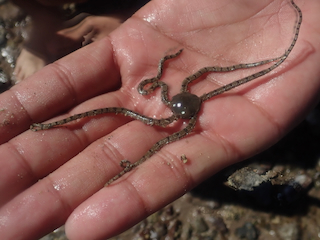
Ophionereis annulata, which is also common in southern California
and further south to Ecuador and the Galapagos Islands.
| 
Stenoplax limaciformis
| 
Ischnochiton tridentatus on the left, and Stenoplax limaciformis on the right
|

Stenoplax limaciformis on the left and two Ischnochiton tridentatus
| 
Acanthochitona exquisita
| 
A. exquisita
|

S. limaciformis
| 
S. limaciformis
| 
I. tridentatus on the left, and S. limaciformis on the right
|

-
| 
Nerites are snails belonging to the family, Neritidae; these are common high in the intertidal
on tropical and many southern hemisphere shores.
| 
-
|

-
| 
A. exquisita
| 
-
|
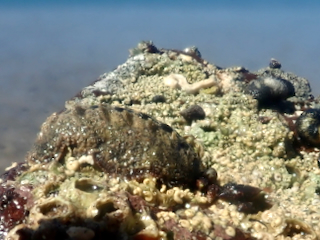
-
| 
-
| 
-
|
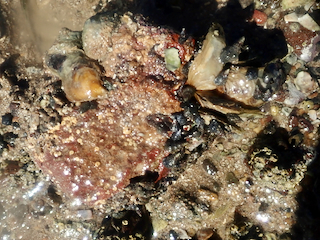
-
| 
-
| 
-
|

-
| 
Mexacanthina angelica was common on this shore. It is endemic to the Gulf of California, whereas its close relative,
the somewhat larger M. lugubris, is found on the Pacific coast of the Baja California Peninsula north to southern California.
| 
-
|

-
| 
The greenish-shelled snail is a member of the trochoidean family, Turbinidae.
| 
Crucibulum spinosum (spiny cup-and-saucer snail)
|

-
| 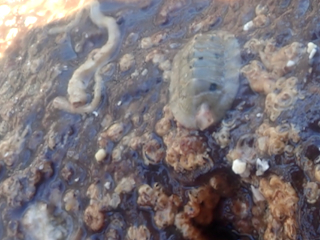
-
| 
-
|

Like other caenogastropod limpet-shaped snails of the family, Calyptraeidae,
C. spinosum is similar to a bivalve in its method of feeding, using its gill to suspension feed on plankton.
| 
S. limaciformis
| 
I. tridentatus
|

S. limaciformis
| 
-
| 
-
|

-
| 
I. tridentatus
| 
-
|

Muricanthus nigritus (English common names include northern radix, black-and-white murex or black murex)
- More about this species at mexican-shells.org website
| 
-
| 
-
|

-
| 
-
| 
-
|

-
| 
-
| 
-
|

Stenoplax limaciformis
| 
-
| 
Stenoplax mariposa
|

A tiny keyhole limpet (Fissurellidae) in front of a colorful polychaete scale worm (Polynoidae).
| 
Like other snails of the family, Calyptraeidae, Crucibulum spinosum are typically sequential hermaphrodites,
changing from a small male when its larger female companion is gone. This small presumed male is surprisingly green and still lacking in spines.
| 
-
|

-
| 
-
| 
Lepidozona sp.?
|

-
| 
-
| 
-
|

Tentative: Pilumnus townsendi - thanks to Greg Jensen for help identifying this to species.
An observation from iNaturalist from La Paz, BCS looks quite similar.
| 
-
| 
-
|

-
| 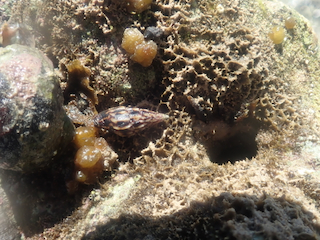
-
| 
-
|

-
| 
Stenoplax limaciformis
| 
S. limaciformis
|

-
| 
-
| 
-
|
Return to DE's Archived WSM Meeting Images
or jump to - Part 1: Meeting in Hermosillo (coming soon) -
Part 2: (Apr. 5) bus trip to Pta. Chueca -
Part 3: (Apr. 5) panga to Isla Tiburón -
Part 4: (Apr. 6) - visit to Guaymas and San Carlos
Return to Biology 317 Fieldtrip Map or
Bio 317 Field Marine Biology Home Page
Web page created on 4/13/25 using ShoresToWeb HyperCard stack by D. J. Eernisse © 2005-2009
 Under Construction!
Under Construction! Under Construction!
Under Construction!